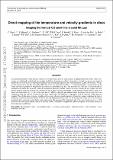Direct mapping of the temperature and velocity gradients in discs. Imaging the vertical CO snow line around IM Lupi
Abstract
Accurate measurements of the physical structure of protoplanetary discs are critical inputs for planet formation models. These constraints are traditionally established via complex modelling of continuum and line observations. Instead, we present an empirical framework to locate the CO isotopologue emitting surfaces from high spectral and spatial resolution ALMA observations. We apply this framework to the disc surrounding IM Lupi, where we report the first direct, i.e. model independent, measurements of the radial and vertical gradients of temperature and velocity in a protoplanetary disc. The measured disc structure is consistent with an irradiated self-similar disc structure, where the temperature increases and the velocity decreases towards the disc surface. We also directly map the vertical CO snow line, which is located at about one gas scale height at radii between 150 and 300 au, with a CO freeze-out temperature of 21 ± 2 K. In the outer disc (>300 au), where the gas surface density transitions from a power law to an exponential taper, the velocity rotation field becomes significantly sub-Keplerian, in agreement with the expected steeper pressure gradient. The sub-Keplerian velocities should result in a very efficient inward migration of large dust grains, explaining the lack of millimetre continuum emission outside of 300 au. The sub-Keplerian motions may also be the signature of the base of an externally irradiated photo-evaporative wind. In the same outer region, the measured CO temperature above the snow line decreases to ≈15 K because of the reduced gas density, which can result in a lower CO freeze-out temperature, photo-desorption, or deviations from local thermodynamic equilibrium.
Citation
Pinte , C , Ménard , F , Duchêne , G , Hill , T , Dent , W R F , Woitke , P , Maret , S , Van Der Plas , G , Hales , A , Kamp , I , Thi , W F , De Gregorio-Monsalvo , I , Rab , C , Quanz , S P , Avenhaus , H , Carmona , A & Casassus , S 2018 , ' Direct mapping of the temperature and velocity gradients in discs. Imaging the vertical CO snow line around IM Lupi ' , Astronomy and Astrophysics , vol. 609 , A47 . https://doi.org/10.1051/0004-6361/201731377
Publication
Astronomy and Astrophysics
Status
Peer reviewed
ISSN
0004-6361Type
Journal article
Description
We acknowledge funding from ANR of France under contract number ANR-16-CE31-0013, from the Australian Research Council (ARC) under the Future Fellowship number FT170100040, from the National Centre for Competence in Research PlanetS supported by the Swiss National Science Foundation, and from the European Union Seventh Framework Programme FP7-2011 under grant agreement no 284405.Collections
Items in the St Andrews Research Repository are protected by copyright, with all rights reserved, unless otherwise indicated.

